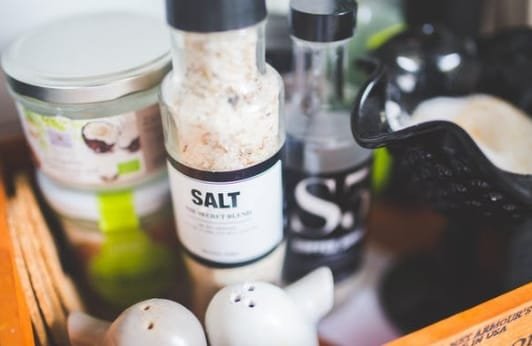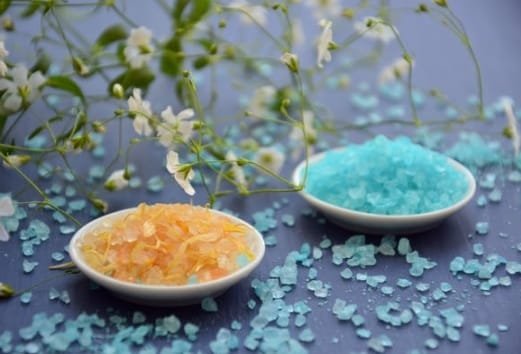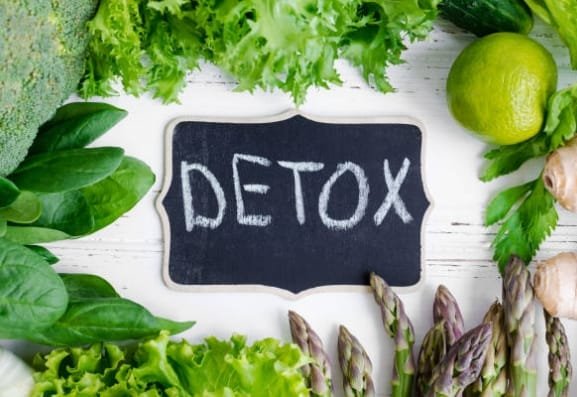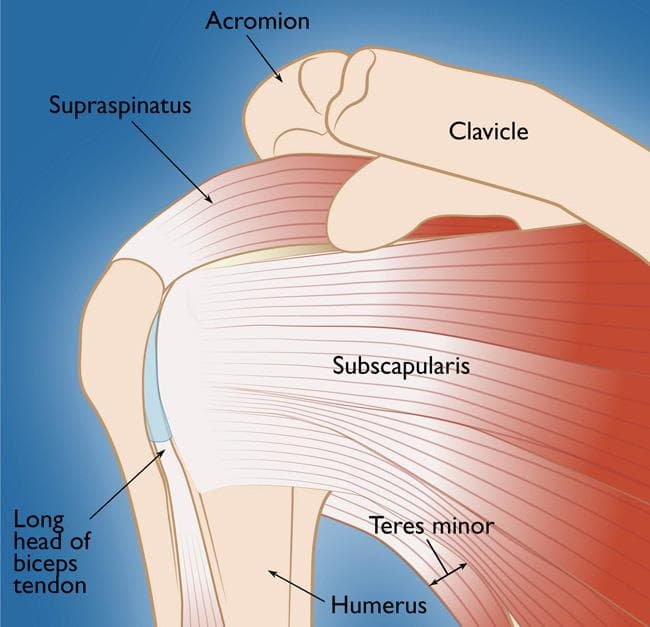
by admin | May 30, 2022 | Health, General
Salt How Much Is Too Much?
Besides carbohydrates, salt has been one of the nutrients in food that has taken a big punch to the face, being often demonized. And though excessive consumption of salt can lead to unwanted side effects, facts remain facts – Salt is a VERY important micronutrient for the body. As a matter of fact, salt provides sodium, which is tightly regulated in the body, meaning that if you have too little, you won’t excrete as much and vice versa – if you have too much, you will excrete more.
In this short article, we’ll tell you more about salt, its functions, roles and recommended daily intake.
What Is Salt?

Salt is essentially made up of sodium & chloride, which are both essential microelements for the body that serve a variety of functions. Salt can be found in certain foods but is widely available in the form of crystals, which is in fact, the main reason why some people over consume it.
What Are The Functions Of Salt?
The main contents of salt (sodium & chloride) both play roles in many of the vital functions of the human body.
Those functions include but are not limited to:
- Carrying nerve impulses
- Muscle contraction
- Fluid balance
One fun fact is that chloride molecules help the body maintain the alkaline-acidic balance, thus helping sodium serve all of its functions properly.
What Is The Daily Recommended Intake?

Now, the good part is that the body has learned how to be efficient with its micronutrients, throughout the millions of years of evolution. Therefore, the body’s sodium needs are not sky high as one may think – those vary from 2 to 4 grams of salt per day. For kids under the age of 10, as well as adults above the age of 65, the daily needs may drop even further.
According to the world health organization, the upper limit for salt intake is around 5 grams, which is equal to about one teaspoon.
Side Effects Of Excessive Salt Consumption
With excessive sodium consumption, it is possible that the kidneys will not be able to excrete the excess amount and thus, levels of sodium in the blood rise. Sodium then binds with water and the total blood volume is increased, leading to an increase in blood pressure. If sustained, high blood pressure can have a lot of consequences for your health, including but not limited to:
- Insult
- Aneurysm
- Worsened kidney function
- Kidney stones
- Cardiovascular problems
Which Foods Contain Salt?
As we mentioned, there are many foods that contain a lot of salt, but those are mostly processed/canned foods.
Such are:
- Canned fish/meats
- Pickles
- Chips
- Instant foods
- Soy sauce
Most natural foods however, such as grass-fed beef, have a naturally low sodium content, putting them in the category of the safest foods to consume. These are the products you should focus on in your nutrition plan, while avoiding any highly processed foods as the ones mentioned above, for the most part.
Take Home Message
To wrap this up, let us tell you this – Salt is not the enemy. Carbs are not the enemy. Fats are not the enemy. The REAL enemy is the lack of balance and the lack of knowledge about what the body actually needs. Salt in and of itself is an ESSENTIAL nutrient, without which you will not function optimally, both physically and mentally.
For this reason, your best bet is to test for yourself and see which amount of salt daily is most suitable for your own activity levels. Some people may feel just fine at 2 grams, while others may need to go up to even 5-6 grams (i.e people who move and sweat a lot). For this reason, you should take all this information with a grain of salt and test for yourself!
Stay safe.

by admin | May 30, 2022 | Health, General
Self Mercy Vs Laziness – What’s the Difference
Many times, we get so occupied with work and responsibilities that we forget to take care of ourselves. When this happens, we attempt to find the time to cool off and pamper ourselves, which is where the concept of “self-mercy” comes in. However, some people believe this to just be used to justify laziness… For example, taking the weekend off work to binge your favorite Netflix movies as a form of self-love.
While this may be the case, oftentimes it is an excuse to procrastinate and be lazy. Though the line between self-mercy and laziness is thin, they are different concepts. Self-mercy is a necessity and should not be confused with laziness, so let us dive further into this.
What is Self-Mercy?

Self-mercy is taking care of oneself and showing yourself appreciation and compassion. It is the process of holding yourself in high regard and prioritizing your happiness and well-being. This is not about gratification as in laziness, rather it motivates you to maintain practices that are beneficial for your physical and mental wellbeing.
It is the perfect way to ease stress and stay productive.
How to Practice Self-Mercy
There is no standard rule for this, it all boils down to preferences and that which brings out your best. Do those things that spark your creativity, improve your mood and enhance your growth.
Here are some simple steps for you.
1. Identify Your Goals
Outline what you intend to achieve, as this will influence your ability to properly integrate self-mercy. Divide these goals into long-term and short-term and brainstorm activities that can move you towards them.
2. Make it a Habit
To become accustomed to self-mercy and make it effective, turn it into a habit. Incorporate it into your daily and weekly routine, and soon enough it becomes a part of you. Pace yourself and start small so you don’t get overwhelmed.
3. Pay Attention to Your Mind
Tune out all forms of distractions and listen to your body, it will inform you when it’s time for resting and pampering. (This is the purest form of self-mercy)
4. Remove Obstacles
You probably shy away from self-love because you believe it is exhausting. Understand that you deserve every form of kindness and find ways to make the process easier for yourself. You could find an accountability partner to help with this.
What is Laziness?

As stated earlier, it is easy to confuse laziness with self-mercy. Whereas self-mercy is a means to recharge for increased productivity, laziness is the act of avoiding tasks that you should be doing. It reduces motivation and hinders us from reaching our goals. If you still can’t differentiate the two, here are the signs of laziness.
1. Procrastination
When you procrastinate, you constantly put off priorities and focus on less important and non-beneficial tasks. This is a challenge faced by many people, and they waste time on unproductive things that prevent them from accomplishing their goals. A lack of self-discipline is one of the major causes of procrastination.
2. You Feel Guilty
Practice will make you know the difference between taking needed time off to recharge, and avoiding important tasks because you were not in the mood. The latter is laziness and will leave you with a sense of guilt because you wasted the time meant for more important activities, the time you will never get back. To avoid this, plan your self-mercy activities.
3. Feeling Fatigued
Doing nothing at all is a sign of laziness, you do not exercise, read, or do any other activity that can contribute to your growth. Instead, you stay indoors all day ignoring your assignments and things that do add value. It is easy to cross the line from just the appropriate amount of self-mercy time to getting fatigued from taking too much time off due to laziness.
Conclusion
Self-mercy is the innate ability to recognize the right moments to take a rest and recharge your batteries. Nevertheless, that does not mean completely relaxing and not doing anything productive, but rather, opening up time for active recovery. Self-mercy can be a challenge at first and may lead you to become lazy without you even realizing it, but once you’ve established a clear border between the two, your self-mercy will allow you to perform better mentally and physically.

by admin | May 30, 2022 | General, Health
Spring Detox – Herbs For Detoxification
Spring a time for detox and herbs are one of the best ways to aid that detox and cleanse.
Herbal remedies are also seeing a rise in popularity once again. This includes using herbs for detoxification. Many people like the idea of using herbs as natural products have minimal side effects. Herbs in fact have many therapeutic abilities. The following list explains some western herbs commonly used for detoxification and why they work.
Dandelion

– This is an herb that is good for the whole body, specifically the immune system. It works to eliminate toxins from the cells in the body. It also increases bile and helps it move along. It is credited with boosting white blood cells thus strengthening the immune system.
Liquorice Root – This herb has properties that work like an antioxidant, fight viruses and helps the body produce antibodies.
Cascara Sagrada – This herb works like a laxative. It helps the bowels move.
Black Walnut Hulls – This herb also works in the bowels. It works against parasites and removes them from the intestines. It also helps remove fatty material and toxins.
Garlic – Garlic is the classic kitchen-pharmacy remedy and has been used for centuries as an antiseptic. It detoxifies the gut and helps the bowels function properly. It works like a laxative in making the bowels move regularly.
Goldenseal – this herb is well known for its cleansing power. It can rid the body of toxins and help to remove obstructions.
Psyllium – This herb also works to help move the bowels.
Here are some Chinese herbs that are used for detoxification.
Lian Qiao is the forsythia flower. It has a cleansing action and helps to clear heat and toxins.
Ju Hua Otherwise known as the Chrysanthemum. This is a pungent herb that should not be overcooked, or it will lose its potency. It has cleansing properties.
Pu Gong Ying

is the dandelion plant. It is the parts of the plant above the root that is being used as a remedy. It is effective as a detoxification herb. It is important to know that the main point of detoxification is removing toxins from the body, usually through the bowels. Using herbs is gentler on your system than other methods and you get additional benefits from the nutrients that herbs supply.
If in doubt always consult a herbalist or naturopath.

by admin | May 30, 2022 | Health
Shoulder Injuries & The Rotator Cuff | Part 1 – Anatomy & Common Injuries
When it comes to athletic performance, the shoulder is pretty much the most utilized part of the upper body. Practically, every exercise that targets a specific upper body muscle group, requires some kind of movement in the shoulder joint. Now, here is something important right away – The shoulder joint has the biggest range of motion out of all joints in the body.
However, that big range of motion comes at the price of joint stability, making the shoulder one of the most vulnerable joints in the body. Shoulder injuries are common and without a doubt the worst type of injuries. This is due to the fact that they basically force you to completely stop upper body training for some time.
In this series of articles, we are going to look into the shoulder, its anatomy, functions, and exercises to help you strengthen it and prevent injuries. Of course, the superficial deltoid muscles are just one part of the shoulder, beneath which we can find the more important, stabilizing muscle groups.
Without further ado, let’s have a look at the shoulder, in-depth.
Shoulder Muscles Anatomy

The shoulder joint is a ball & socket joint, located between the humerus (upper arm bone) and the scapula. The main muscles of the shoulder joint are: The deltoids (Front, side & rear)
- Supraspinatus
- Infraspinatus
- Teres Minor
- Teres Major
Now, though most of us focus mainly on the deltoids with overhead pressing movements & lateral raises, the last 4 muscles on the list above are often neglected. These 4 little muscles make up what we refer to as the “Rotator cuff”.
The rotator cuff is what actually stabilizes the shoulder joint and if well-developed makes it far less likely for a shoulder injury to occur. Besides serving as a good injury prevention tool, a healthy rotator cuff will also make you stronger on every other upper body movement. This is especially valid for pushing movements, where the arms are unstable under bigger loads.
Functions of the shoulder
Each of the shoulder joint muscles is responsible for certain movements, so let us briefly explain those.

The Deltoids
The superficial muscles of the shoulder are the deltoids, which surround the shoulder joint from all sides. This is why the deltoids are further separated into 3 zones:
- Anterior (front) deltoids
- Medial (side) deltoids
- Posterior (rear) deltoids
The front deltoid head gives a rounder look from the front and is mainly engaged when you lift your arm up from the front. Next to it is the side deltoid, which can give the shoulder line a wider look and is primarily engaged when you lift your arm laterally (to the side).
Lastly, the rear deltoid gives the shoulders a complete, round look, and is primarily engaged when you do movements that pull the shoulder back. Now, though these are the main functions of the deltoid muscles, none of the 3 are ever completely isolated from one another. These muscles always work in synergy but depending on the exercise, one of the 3 is emphasized.
The Rotator Cuff
Beneath the deltoids are the deep shoulder muscles, which as we mentioned, serve as stabilizers of the shoulder joint. The supraspinatus goes from the upper portion of the shoulder blade and attaches to the head of the humerus. Functionally, the supraspinatus absorbs some of the tension that falls on the shoulder joint and more importantly, keeps the head of the humerus firmly pressed in the shoulder socket.
The infraspinatus is one of the bigger rotator cuff muscles, as it covers most of the shoulder blade and again, attaches at the humerus head. In terms of functionality, this is the muscle that is primarily responsible for the external rotation of the shoulder but also stabilizes the shoulder joint at its socket.
Teres Minor is a relatively small muscle of the rotator cuff, which goes from the lower lateral portion of the shoulder blade, to the head of the humerus. The main functions of the teres minor are external rotation and arm adduction (the movement of the arm towards the midline of the body).
Teres Major is one of the thicker rotator cuff muscles, which goes from the lower portion of the shoulder blade and attaches to the front of the humerus head. This muscle is engaged during arm extension, as well as internal rotation of the arm.
Common Shoulder Injuries

Now that you know some basic anatomy of the shoulder joint, let’s talk about the most common sports-related shoulder injuries. The most common injuries of the shoulder are caused by inflammation, strain, or in the worst case, a complete rupture of one or more tendons of the shoulder musculature.
Now, there are a number of reasons why these injuries occur, but it is important to acknowledge this – The shoulder tendons (and tendons in general) have a weak blood supply as opposed to the muscles. This, therefore, leads to a lesser amount of oxygen and nutrients going to those tissues, making them far more susceptible to degeneration as we age. The second most common reason for shoulder injuries is systematic overexertion with exercises that engage the shoulder, as well as a poor exercise form.
Common shoulder injuries include:
This is a displacement of the shoulder from its normal position in the socket. A dislocation is usually the result of an impact/fall or overexertion at an awkward angle.
The frozen shoulder is another common injury, which is usually the result of inflammation of the shoulder socket. A frozen shoulder is usually accompanied by stiffness, pain, and limited range of motion in the shoulder joint.
This type of injury is common in athletes who mainly use the upper body at high levels of exertion and awkward angles (think rock climbing). With resistance training, this type of injury often occurs during high exertion on heavy pressing movements like the bench press and the overhead shoulder press.
It is mainly expressed in shoulder pain, instability, and limited range of motion. Most tears are partial, but in severe cases, a tendon may completely come off the bone.
Bursae are small, lubricating sacs located in joints across the body. In the shoulders, the bursae are located between the rotator cuff & the bone above the shoulder (acromion). Bursitis is essentially a condition that occurs when that lubricating sac gets inflamed and usually results in pain, tenderness, and a decreased range of motion.
Acknowledgments
In the second part of this article series, we are going to tell you more about the means of preventing shoulder injuries, as well as exercises to make the shoulders bigger and stronger.
Here are some important takeaways from this article:
- The shoulder joint is the most mobile joint in the body, but also one of the less stabilized, which makes it susceptible to injury.
- This joint is involved in all upper body movements, which is why training intensity & programming should be carefully managed
- Besides the superficial deltoids, the shoulder has stabilizer deep muscles known as the “rotator cuff”
If you have not yet experienced a shoulder injury, there are preventative measures you can (and should) consider, even if your shoulders are completely healthy. In the second article of this series, we are going to discuss shoulder stabilizing & strengthening exercises, as well as workout tips.
All of these will ultimately help you maintain shoulder health and avoid any type of injuries.
See you in the next article!

by admin | May 29, 2022 | Health, General
Introduction to Acupuncture
The basic principle of Traditional Chinese Medicine is that there are two opposing and interwoven forces within our bodies. Yin and Yang represent the entire person. In Chinese philosophy, Yin represents the cold, tranquil or passive principle, and Yang represents the active, energetic or hot principle.
So what is it and where does it come from?

Acupuncture is one of the oldest medical procedures in the world, it was first used over 2000 years ago in China. In this family of procedures, the body is stimulated, and the energy flow is balanced. Today, acupuncture is practised by hand or by electrical stimulation using tiny metallic needles placed in problematic areas.
Traditional Chinese Medicine is built around acupuncture, which is based on the belief that our bodies contain two opposing forces that cannot be separated.
By maintaining a balance between yin and yang, a healthy state can be achieved. The flow of vital energy may then be stimulated through channels known as meridians. Meridians are pathways along which vital energy flows. Around 2,000 points along the body are connected by these meridians.
Twelve main meridians and eight secondary meridians are identified. Western medicine is still unclear as to how acupuncture works, but several studies have shown that it can be effective.
Having said that, let us proceed to the next question: Does it actually work?
In the National Institute of Health’s opinion, the answer is yes. The effects of acupuncture have been demonstrated in many areas of health care. The list includes postoperative nausea, side effects of chemotherapy, osteoarthritis, low-back pain, headaches, menstrual cramps, addiction, carpal tunnel syndrome, and asthma. The study revealed that acupuncture was able to provide pain relief, improve function and mobility of joints due to arthritis inflammation, and served to complement standard care.
It is also commonly used in fertility and with emotional issues.

Some may doubt the effectiveness of acupuncture, but once they have experienced it, they are believers. According to some studies, acupuncture works by regulating the nervous system. Since acupuncture induces stimulation of the nervous system to produce its effect, endorphins and immune system cells are released at specific sites on the body. Acupuncture is also thought to affect brain chemistry by changing the neurotransmitters in the brain.
According to studies, acupuncture was a benefit to those taking part, and as someone who has used it, I can attest to its beneficial effects. In spite of acupuncture’s classification as an alternative medicine treatment, and despite its unknown mechanisms, treatment has been proven to aid in maintaining optimal health.
Does acupuncture have any benefits for those who are otherwise healthy?
Absolutely. Since acupuncture is based on the belief that vital energy flow must be maintained in order to remain healthy, it acts as a tool for realignment.
Despite feeling and appearing quite healthy, our vital energy flow can be out of balance. Therefore, acupuncture is as much preventive medicine as it is a treatment. Getting your meridian points checked and balanced before it needs repair is like having your car receive a tune-up.
So get yourself booked in and prepare to rev up that amazing engine of yours
Disclaimer Note: It’s important to note though, that just because something is natural does not mean zero risk. While many Chinese Therapies are very low risk there still may be complications, contraindications and contra-actions.
The internet is full of information on how you can cure yourself with natural remedies, Chinese medicine and more, but we recommend that you seek out a Qualified Natural Health Practitioner, Chinese Medicine Practitioner or TCM Doctor or Acupuncturist expert and always consult a Doctor before trying any new things. Never stop taking any prescribed medication without speaking to your health practitioner first.

by admin | May 29, 2022 | Health, Mind
Is passive aggression good for you?
Everybody has got a friend that just acts out passive-aggressively. You don’t blame them, nor do you want to judge. Maybe sometimes you do it, too. But what does it actually say about you? Let’s first talk about the different communication styles and differentiate one from the other.
4 Styles Of Communication

Passive communicators typically avoid expressing their true emotions or feelings as not to engage in confrontational conversations. It’s an excellent method for not hurting someone’s feelings, but there is always a chance you will fall into a pit. Many people that express themselves passively fall into depressive moods, feel anxious, and can’t get a grip on real emotions.
Aggressive communicators are mainly focused on the Ego and step into a conversation thinking not for the other conversationalists’ emotions or thoughts. People that communicate like this often leave others to feel afraid, insecure, intimidated, and in general discomfort.
Passive-aggressive communicators are the ones that present themselves as passive but, at a certain moment, reveal anger simultaneously. Most people communicate like this because they feel powerless or don’t stand up intellectually to the level of the conversation.
Assertive communicators are the healthiest communicators of them all. They clearly state their attitude and feelings while taking in mind other people’s thoughts and feelings.
The Passive-Aggressive Epidemic
As we’ve concluded that passive aggression isn’t good for us, then comes the question – why are there so many people that communicate like that? Think about It – in many cases of having to meet new people or engaging in conversations with people that you already know comes a moment when one of you becomes passive-aggressive.
There are a few reasons for that.
So, let’s start with…
Understanding Anger

One of the basic and most typical of human emotions is anger. We are taught that anger is bad in an early stage of our lives. It’s either in school or at home we need to suppress the anger in order to be socially approved. All this leads to hiding your anger and pushing it in the closet so as not to offend someone or seem not normal. This kind of social pressure leads to an unhealthy emotional base for conversations.
You’re Sugarcoating It
Anger doesn’t just vanish after you’ve suppressed it. It’s there, and it’s building up. The result is you being confused as to how you are supposed to speak with others so you start to express yourself in alternative ways which leads to passive aggression.
It’s Simply Easier
It is way easier to be passive-aggressive than assertive. Learning how to communicate is something that you build step-by-step in your younger years.
If It’s not tough at the right age, there are quite a few symptoms that can show later in life. Sulking, Indirect communication, and emotional withdrawal are the results of the lack of social knowledge.
You Feel Like You HAVE TO
At a certain point, you feel like in order to reach a specific stage in your professional growth you can’t be assertive because people see it as a weakness.
This becomes a model of approach in your life, and you cannot let yourself seem weak by being Mr. goody-two-shoes.
It’s… Rational?
Often in our lives, we like to rationalize things that seem to be a part of us without thinking they actually may be bad. In a scenario where we procrastinate, don’t feel like doing something or we’re overall lazy we use passive aggression as a tool to seem like the victim. This is a severely common practice in our modern society, and If not stopped at an early age, it becomes a life-altering behavior.
Nevertheless, Remember…
Though passive aggression is normal and in fact, quite common, it is a form of anger that people don’t want to show outwardly. They may not say anything at all, but they will get their revenge in other ways by doing things like withholding affection or refusing to help with tasks around the house.
If you’re feeling passive-aggressive and need some emotional balance, try these three quick tips:
- 1) take care of yourself (nourish your body and mind)
- 2) make time for self-care (take a bubble bath or read)
- 3) practice mindfulness meditation techniques such as deep breathing exercises when you feel the rage boiling up inside.
Stay ZEN!

























